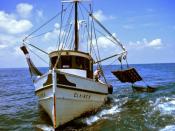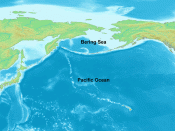Commercial fishing is a worldwide enterprise that involves the capture of marine and freshwater fish and shellfish and their preparation for market. Fishing equipment ranges from small boats whose nets are cast and hauled in by hand to factory ships equipped with the most advanced technologies for finding, harvesting, and preparing huge amounts of fish. These large catches are very costly, however, not only in the price of their equipment and fuel, but also in the depletion of fishery resources their use brings about.
The major portion of the total fish harvest consists of few fish species, which are divided into two primary groups. Pelagic species - those which live in the near-surface layers of the oceans, this include several species of herring, tuna, salmon, anchovies, pilchard, sardines, menhaden, and mackerel. Demersal species - fish that live in the near-bottom layers of the ocean, this includes cod, sole, halibut, haddock, hake, and flounder.
Large catches are also made of a group of fish classed commercially as SHELLFISH - shrimp, lobster, scallops, oysters, clams, crabs, mussels, and squid. WHALING was once a major part of the fishing industry. Overfishing has endangered many whale numbers, however, and the field has lessened in importance.
Almost all large pelagic and demersal fish catches are made over or near the continental shelf, the underwater plateau around the continents and large islands. In these waters temperatures, water depths, and the currents that influence the amounts of available food create an environment that is highly favourable to the existence of large schools of fish.
The animals living in and on the bottom of the continental shelf serve as additional food sources for demersal fish. Also, most species spawn on continental shelves, and the main nursery grounds of many species are also in coastal regions. The main fishing...



Fishing
Very informative and disturbing.
0 out of 0 people found this comment useful.